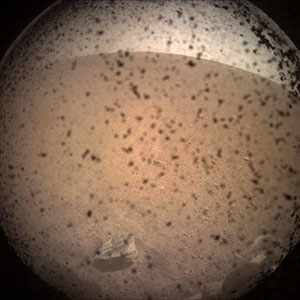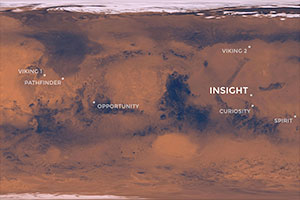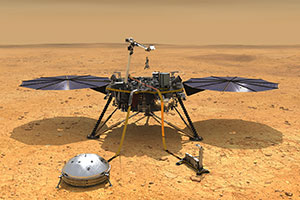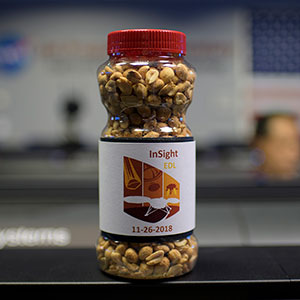November 26, 2018 — A new spacecraft has successfully landed on the surface of Mars for only the eighth time in history.
NASA's InSight lander touched down Monday (Nov. 26) at 11:44 a.m. PST (1944 GMT) after a nearly seven-month journey from Earth. Due to the time it takes light to travel between the two planets, it was about 8 minutes later when the mission team at NASA's Jet Propulsion Laboratory (JPL) in Pasadena, California erupted in applause.
"Touchdown confirmed!" announced engineer Christine Szalai from JPL's mission control after the signal confirming the landing was received at 11:52:59 a.m. PST (1952 GMT).
InSight, or Interior Exploration using Seismic Investigations, Geodesy and Heat Transport, is equipped with science instruments to study the deep interior of Mars. By recording data about marsquakes, meteorite impacts and how heat dissipates below the surface, researches hope to learn more about how rocky planets, such as Mars and Earth, are formed.
"That is the goal of the InSight mission, to actually map out the inside of Mars in three dimensions so we understand the inside of Mars as well as we understand its surface," said Bruce Banerdt, InSight's principal investigator at JPL.
An experimental pair of cubesats, Mars Cube One (MarCO), which were launched with and accompanied InSight on its transit to Mars, were used to relay the data from InSight during its final approach to the planet. The small satellites are the first of their kind to operate beyond low Earth orbit.
Entry, descent and landing
InSight's landing on the lava plains of Mars' Elysium Planitia — or what NASA described as the "the biggest parking lot" on the red planet — concluded a voyage of almost 300 million miles (480 million kilometers) since InSight became the first interplanetary probe to launch from the United States' west coast on May 5, 2018.
Much of InSight's cruise to Mars was uneventful, with the exception of six trajectory correction maneuvers (the last executed a day before the landing), until about 14 minutes before its touchdown.
At 11:40 a.m. PST (1940 GMT, Earth-receive time), InSight's aeroshell, with the lander enclosed, separated from the cruise stage that carried the mission to Mars. That was followed seven minutes later by atmospheric entry at about 12,300 mph (19,800 kph), beginning the entry, descent and landing phase, or the so-called "seven minutes of terror."
InSight entered the Martian atmosphere at 2,188.6 miles (3,522.2 km) from the center of the planet, or about 80 miles (128 km) above Elysium Planitia (though it was not directly above the landing site, but about 440 miles [708 km] west of it). Two minutes into the descent, the aeroshell's heat shield reached its peak heating of about 2,700 degrees Fahrenheit (1,500 degrees Celsius).
At 11:49 a.m. PST, InSight deployed its parachute. The 39-foot-diameter (11.8-meter) canopy was similar to the one used by NASA's Phoenix lander in 2008, but given InSight's greater mass (about 77 pounds or 35 kilograms more) and higher landing site elevation, the current mission's parachute was equipped with stronger material for its 40 suspension lines.
Fifteen seconds after the chute deployed, the spacecraft separated from its heat shield. Ten seconds after that, InSight deployed its three legs.
At 11:51 a.m. PST, InSight acquired its first radar signal, registering the distance it was to the ground. Twenty seconds later, the lander separated from its back shell and parachute.
In free fall, InSight ignited its 12 retrorockets to control and slow its descent from 17 mph to a constant 5 mph (27 kph to 8 kph). About 15 seconds later, sensors at the top of each of the lander's shock-absorbing legs detected the surface pushing back and triggered the thrusters to cut off.
Starting from the surface
With InSight now on the surface, the first focus for the lander's team is to its two primary science instruments on the ground.
Over the course of the next three weeks, InSight will use its 5-foot, 11-inch (1.8 m) robotic arm and cameras to survey its surroundings, taking stereoscopic (or three-dimensional) imagery for scientists to use to determine the best place to set down their equipment.
The Seismic Experiment for Interior Structure (SEIS), a seismometer provided by a consortium led by France's national space agency, the Centre National d'Études Spatiales (CNES), will be the first instrument lifted from InSight's deck and placed directly on the ground. The move will require several Martian days ("sols") to verify that the robotic arm has a solid grasp, if for no other reason than it will be the first time a robotic arm has ever grasped anything on another planet.
Next, the arm will be used to place a wind and thermal shield over SEIS so it can begin monitoring Mars for vibrations. Scientists expect between a dozen and one hundred marsquakes over the course of InSight's first two Earth years on the surface. The quakes are likely to be no bigger than a 6.0 on the Richter scale, but will be of enough energy to reveal details about the planet's interior.
The Heat Flow and Physical Properties Probe (or HP3, pronounced H-P-cubed), provided by the German Aerospace Center DLR, will be the next instrument to be lowered to the surface.
After it is on the ground, the probe will release its self-hammering mole. Burrowing downward over the course of a few weeks, it will pause at intervals to allow heat from the hammering action to dissipate for two or three sols and will then measure thermal conductivity before proceeding deeper.
HP3 will take about seven weeks to burrow 15 times deeper beneath the surface than any earlier hardware sent to Mars and provide the first precise determination of the amount of heat escaping from the planet's interior.
InSight will conduct a third study, the Rotation and Interior Structure Experiment (RISE), but it does not have its own instrument. Instead, RISE uses the lander's direct radio connection with Earth to measure deviations in Mars' rotational axis, providing more information about the Mars' core.
Throughout its surface operations, which under its primary mission will last one Martian year plus 40 sols (or through Nov. 24, 2020), InSight will relay its instruments' findings through NASA's Mars Reconnaissance and Mars Odyssey orbiters.
Eighth at Mars
InSight is the eighth spacecraft to successfully land on the surface of Mars, all of them launched by the United States.
InSight joins Curiosity, NASA's Mars Science Laboratory rover, as the other currently active mission on the red planet. InSight landed about 340 miles (550 km) from Curiosity, which is six years into exploring Mars' Gale crater.
The space agency's previous landings included the Viking 1 and 2 probes in 1976, Mars Pathfinder with the Sojourner rover in 1997 and the Mars Exploration Rovers Spirit and Opportunity in 1994 (Opportunity ceased communicating with Earth in June 2018 due to a Martian dust storm; NASA is still listening for its signal, hoping to regain contact).
InSight uses the same lander body design as NASA's Phoenix mission, which was operational in Mars' polar region from May through November 2008.
The $1 billion InSight mission is led by NASA with major contributions from France and Germany. The other countries involved are Austria, Belgium, Canada, Italy, Poland, Spain, Switzerland and the United Kingdom. |
|

Illustration showing NASA's InSight about to land on the surface of Mars on Nov. 26, 2018. (NASA/JPL-Caltech)

The first photo returned by InSight after landing on Nov. 26, 2018. The image was taken through the camera's dust cover. (NASA)

NASA's InSight lander seen during a solar array deployment test at Lockheed Martin's clean room in January 2018. (Lockheed Martin)

The location of the landing site for InSight is indicated on this global map of Mars, which also indicates landing sites of current and past NASA missions to the surface of Mars. (NASA)

Artist's concept of NASA's InSight lander after it has deployed its instruments on the Martian surface. The Seismic Experiment for Interior Structure (SEIS) instrument is on the left, the Heat Flow and Physical Properties Package instrument is on the left. (NASA)

Continuing a tradition started during the Ranger 7 mission in 1964, a can of "lucky peanuts" sits on a console inside InSight's Mission Control room at the Jet Propulsion Laboratory. (NASA/Bill Ingalls) |
